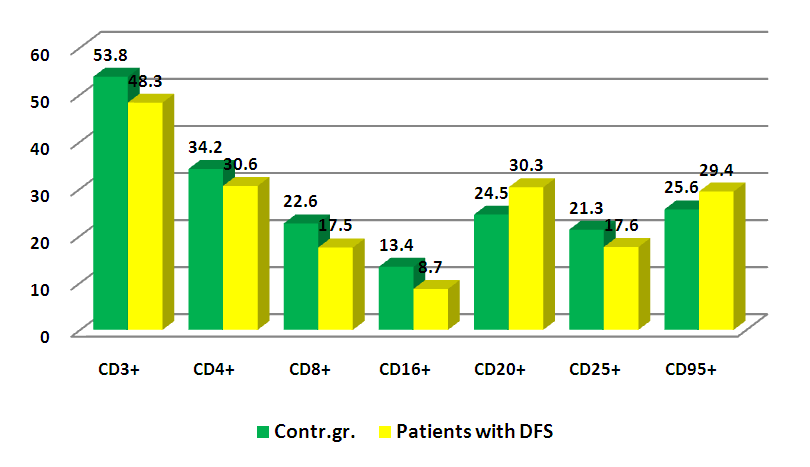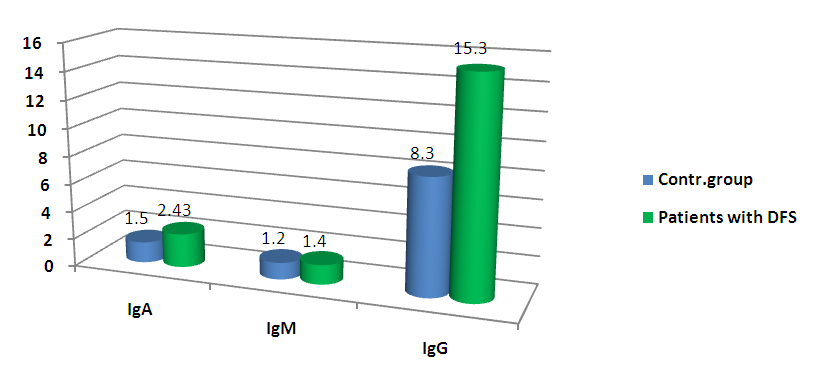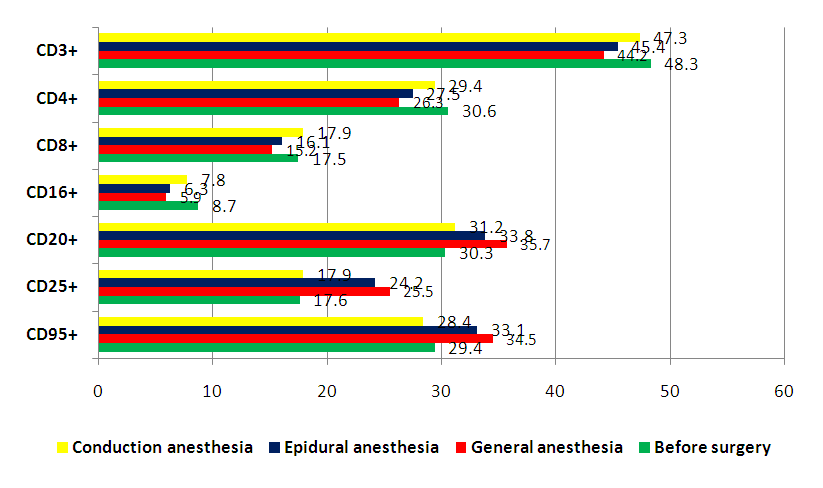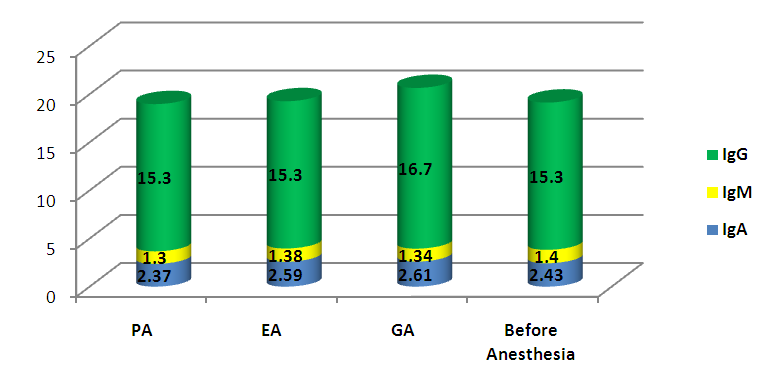-
Paper Information
- Next Paper
- Previous Paper
- Paper Submission
-
Journal Information
- About This Journal
- Editorial Board
- Current Issue
- Archive
- Author Guidelines
- Contact Us
American Journal of Medicine and Medical Sciences
p-ISSN: 2165-901X e-ISSN: 2165-9036
2022; 12(5): 519-523
doi:10.5923/j.ajmms.20221205.14
Received: April 13, 2022; Accepted: May 8, 2022; Published: May 12, 2022

Characteristics of Cellular and Humoral Immunity in Various Types of Anesthesia in Patients with Diabetic Foot Syndrome
Khamdamov Bakhtiyor Zarifovich1, Oltiev Usmon Bebitovich1, Sabirov Jurabay Marifbaevich2
1Bukhara State Medical Institute, Bukhara, Uzbekistan
2Tashkent Medical Center for Advanced Training of Doctors, Uzbekistan
Correspondence to: Khamdamov Bakhtiyor Zarifovich, Bukhara State Medical Institute, Bukhara, Uzbekistan.
| Email: |  |
Copyright © 2022 The Author(s). Published by Scientific & Academic Publishing.
This work is licensed under the Creative Commons Attribution International License (CC BY).
http://creativecommons.org/licenses/by/4.0/

Introduction. In the structure of morbidity of residents of economically developed countries, diabetes mellitus occupies one of the first places. Its prevalence is 1.5–6%. Lesions of the lower extremities of various genesis occur in 30-80% of people with impaired carbohydrate metabolism. Objective: comparative study of the effect of general, epidural and conduction anesthesia on the state of cellular and humoral immunity in patients with diabetic foot syndrome. Methods: 48 patients with diabetic foot syndrome were examined, who made up 3 groups depending on the use of anesthesia methods: group I - 14 patients (29.2%) operated under epidural anesthesia (EA). Group II–19 (39.6%) patients who were anesthetized by conduction anesthesia (CA). Group III - 15 (31.2%) patients who underwent general anesthesia (GA). The number of lymphocytes with CD3, CD4, CD8, CD20 phenotype in peripheral blood was studied and the level of IgG, IgA, IgM in blood serum was determined by ELISA. The results obtained: it was revealed that in patients who underwent GA, deeper changes in immunity were observed than the initial data. The indicators of patients who underwent EA are somewhat better. In patients who underwent surgery using PA, immunological parameters remained at the level of baseline data. Therefore, CA is a more gentle anesthesia with respect to its effect on the parameters of the immune system. Conclusions. From the position of influence on cellular and humoral immunity, the method of choice for operations on the lower extremities in patients with diabetic foot syndrome is conductive anesthesia (CA) based on stem nerve blockades.
Keywords: Diabetic foot syndrome, Anesthesia, Cellular and humoral immunity
Cite this paper: Khamdamov Bakhtiyor Zarifovich, Oltiev Usmon Bebitovich, Sabirov Jurabay Marifbaevich, Characteristics of Cellular and Humoral Immunity in Various Types of Anesthesia in Patients with Diabetic Foot Syndrome, American Journal of Medicine and Medical Sciences, Vol. 12 No. 5, 2022, pp. 519-523. doi: 10.5923/j.ajmms.20221205.14.
Article Outline
1. Introduction
- In the structure of morbidity of residents of economically developed countries, diabetes mellitus (DM) occupies one of the first places. Its prevalence is 1.5–6%. Lesions of the lower extremities of various genesis occur in 30-80% of people with impaired carbohydrate metabolism. Often these lesions are complicated by the development of chronic ulcerative defects, which, with untimely diagnosis and inadequate treatment, lead to amputation of the affected limb. Every hour in the world 55 amputations of the lower extremities occur in patients with diabetes mellitus [1,2,3]. Despite significant advances in the study of the pathogenesis of diabetes mellitus and its complications, the number of leg amputations in diabetes is growing. For the first time, an ulcerative defect on the foot, as a rule, turns into a recurrent one. Within 5 years, ulcerative defects recur in 70% of cases [4,5,6]. Modern means and methods of intraoperative anesthetic protection should ensure the normal functioning of all life support systems, have a high level of safety, be convenient and accessible to use, guarantee a high "quality of life" to the patient in the postoperative period, and also contribute to the fastest possible restoration of the structural and functional integrity of organs and tissues [7,8,9,10].There is still a discussion in the literature about the choice of the optimal method of anesthesia for operations performed for diabetic foot syndrome (DFS). A sufficient amount of data has been accumulated indicating the advantage of neuroaxial anesthesia in comparison with general anesthesia [5,6,7].Literature data on the effect of various anesthesia methods on the immune system in patients with SDS are few and contradictory [3,9,10].
2. The Aim of the Study
- The aim of the study is to compare the effect of general, epidural and conduction anesthesia on the state of cellular and humoral immunity in patients with diabetic foot syndrome.
3. Materials and Methods of Research
- The study included 48 patients diagnosed with diabetic foot syndrome who were on inpatient treatment in the department of purulent surgery of the Bukhara Regional Multidisciplinary Medical Center. The average age of the patients was 62.5 years. Many patients (39.57%) were at the age of labor activity (from 45 to 60 years). In most cases of observation, patients suffered from type 2 diabetes mellitus (94.5%), where mainly moderate and severe degrees of severity of diabetes mellitus in the stage of subcompensation and decompensation were observed. 57.9% of patients had gangrene of the toes and 34.6% had gangrene of the distal parts of the foot.Depending on the types of anesthesia, the patients were divided into 3 groups: Group 1 – 14 patients (29.2%) operated on for SDS under general anesthesia (GA). The second group consisted of 19 (39.6%) patients who underwent anesthesia during surgical interventions on the lower extremities by epidural anesthesia (EA). The third group consisted of 15 (31.2%) patients who underwent conduction anesthesia (stem blockade) (PA).Immunological studies were carried out by quantitative study of the number of lymphocytes with the CD3, CD4, CD8, CD20 phenotype in peripheral blood using monoclonal antibodies of the LT series (Sorbent LLP; Moscow, Russia), determination of the level of IgG, IgA, IDM in blood serum by the ELISA method using the test system of Vector Best LLC (RF), according to the attached instructions. The control group consisted of 20 practically healthy individuals of the same age. Studies in patients were conducted before and after surgery.The research materials were subjected to statistical processing using the Student's t-test, using the standard Windows 2000 statistical software package.
4. Results and Their Discussion
- An analysis of the anamnestic data of the examined patients showed that by the nature of concomitant diseases, the patients of the designated groups were homogeneous. The following nosologies were most common: Coronary heart disease, PIX, arterial hypertension, COPD, diabetic nephropathy.The results of the study showed that, in general, in the group of patients who underwent general anesthesia (GA), there was a relative instability of hemodynamic parameters at all stages of the operation. 4.0% of patients had cardiac arrhythmia, 8.0% of cases had uncontrolled hypotension. In 11.0% of patients, the duration of post-acute awakening was observed, in 7.0% of patients hypoglycemic state. In 12.0% of cases, the recurarization of relaxants was observed. Moreover, difficulties in tracheal intubation were noted in 8.0% of cases. Epidural anesthesia (EA) was performed according to a generally accepted method using a special set of "Espokan". The results of the study showed that in the group of patients who underwent EA, there was a relative instability of hemodynamic parameters in 8.5% of patients. 2.0% of patients had cardiac arrhythmia, 2.0% of cases had uncontrolled hypotension, 10.5% had bradycardia, 5.0% of patients had technical difficulties performing epidural anesthesia.In patients of the third group operated under conditions of conduction (stem-nerve blockade) anesthesia, 14-15 minutes after the blockade of the nerve trunks, the effect of anesthesia was manifested, which persisted at all stages of the operation and no additional administration of analgesics was required. Hemodynamic parameters were fairly stable. At the same time, respiratory dysfunctions were not observed. The duration of analgesia in the postoperative period lasted from 7 hours to 11 hours. There were no serious complications associated with anesthesia, but the following reactions were noted: 5.0% of patients developed headache after the introduction of a local anesthetic, 2.0% developed nausea, and 3.5% of patients had muscle tremors. These symptoms were regarded by us as a toxic effect of the anesthetic. In 3.0% of patients, bradycardia was noted, which was stopped by the introduction of an atropine sulfate solution. It should be noted that the conduction of anesthesia provided a complete blockade of nociception during surgical interventions on the lower extremities, as well as a smooth course of the postoperative period with rapid activation of patients, that is, an early return to the usual meal intake and insulin therapy regimen, activity within the bed, verticalization in a sitting position. All patients underwent routine noninvasive hemodynamic monitoring using DASH 3000 monitors: ECG, blood pressure, heart rate, SpO2.Analysis of the results of immunological studies in patients with SDS showed that changes in cellular and humoral immunity are observed compared with the data of the control group (Fig. 1).
 | Figure 1. Показатели клеточного иммунитета у обследованных лиц |
 | Figure 2. Indicators of humoral immunity in the examined persons |
 | Figure 3. Dynamics of cellular immunity parameters in the examined patients |
 | Figure 4. Dynamics of humoral immunity indicators in the examined patients |
5. Conclusions
- 1. The use of general anesthesia during operations on the lower extremities in women with diabetic foot syndrome, is accompanied mainly by the suppression of all links of cellular and humoral immunity.2. The use of epidural anesthesia is accompanied by less tension of regulatory systems, which contributes to the conservation of protective resources of the body and the development of a favorable adaptation strategy.3. From the position of influence on cellular and humoral immunity, the method of choice for operations on the lower extremities in patients with diabetic foot syndrome is conductive anesthesia (CA) based on stem nerve blockades.Information about the source of support in the form of grants, equipment, and drugs. The authors did not receive financial support from manufacturers of medicines and medical equipment.Conflicts of interest: The authors have no conflicts of interest.
 Abstract
Abstract Reference
Reference Full-Text PDF
Full-Text PDF Full-text HTML
Full-text HTML